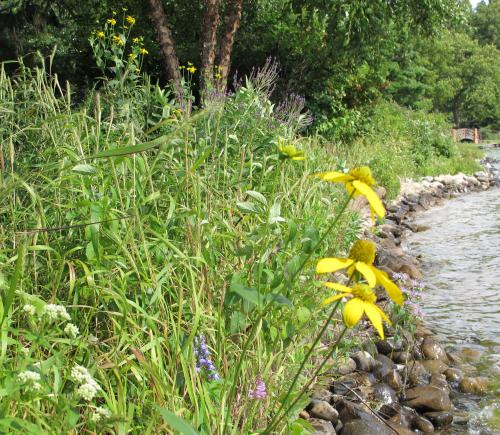Rebuilding an eroding bank on an inland lake
Study compares two natural shoreline erosion control techniques suitable for moderate to high energy lakefront properties.
A new Michigan State University Extension publication (E3198), “Rebuilding an Eroding Bank on an Inland Lake,” provides guidance on techniques for rebuilding eroded banks along inland lakes. This free-for-download pdf highlights findings of a three-year study during which two types of encapsulated soil lifts, constructed at MSU’s W.K. Kellogg Biological Station, were compared. The study was funded by Project GREEEN.
Every year, more people buy or build homes, cabins or recreation spaces on one of Michigan’s many inland lakes. In years past, if their shorelines showed signs of erosion from wind, wave and ice action, many shoreline property owners would “harden” them with rock riprap or vertical seawalls. Unfortunately, this practice has resulted in the cumulative loss of shoreline and shallow water habitat on Michigan inland lakes.
Using a more natural erosion control measure, such as an encapsulated soil lift (ESL), will create a vegetated, more gently sloped, lake-friendly shoreline.
Photo caption: Native plants colonize encapsulated soil lifts on a rock base to control shoreline erosion on Gull Lake in Kalamazoo County. Photo credit: Jane Herbert
ESLs (sometimes referred to as “vegetated geogrids”) are vegetative bioengineered structures that are usually built on a rock base. They are useful in rebuilding eroded, vertically-faced banks. Soil layers are “encapsulated” inside of biodegradable fabric to form the lift. Each new course, or layer, of lift is placed on the preceding course but stepped back to create the desired slope. Lifts may be continued up to a height of 8 feet. They are planted or seeded to long-rooted native plants that help to stabilize the soil layers.
ESLs on a rock base are especially useful on lakefronts that experience moderate to high wind, wave and ice action, and where significant soil loss has occurred. They may also be used to replace failing seawalls. Once established, these vegetated systems create a new slope with root structures that can withstand the erosive forces of wind, waves and ice.
Waterfront contractors and property owners interested in more lake-friendly methods for rebuilding eroding banks or replacing failing sea walls may download free pdf of MSU Extension publication E3198, “Rebuilding an Eroding Bank on an Inland Lake.” You may also watch a video about constructing soil lifts.



 Print
Print Email
Email

